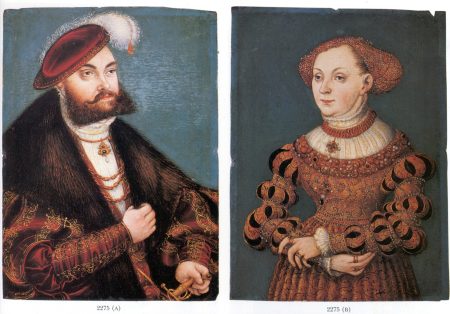
Duke Frederick “the Wise” of Saxony, the famous defender of Martin Luther, was not the only noble in his family to take up the cause of the Reformation. Frederick is well known to history for his clandestine “kidnapping” of Martin Luther on the way home from the Diet of Worms. The courageous Duke Frederick refused to surrender Luther even to the united demands of the Emperor and the Pope.
This noble spirit was passed on to the relatives of the Duke. Duke Frederick “the Wise” was succeeded by his brother John “the Steadfast.” John’s son combined the virtues of his steadfast father and his wise uncle and was aptly named John Frederick. Duke John Frederick of Saxony, the nephew of Frederick was a personal friend to Martin Luther and has been described as “one of the most sincere, devoted, and intrepid defenders of the Reformation.” John Frederick was a giant of a man. His boots were so large that it was rumored that a six-year-old child was able to stand up in one boot without difficulty! At the age of 24, Duke John Frederick took as his bride a tender young girl named Sibylle of Cleves. She was only 17 years old at the time. Although she was raised in Romanism, she was a convert to the Lutheran faith, and eagerly embraced the truth of faith alone in Jesus Christ alone for salvation.
Sibylla was elder sister to Anne of Cleves, a girl destined one day to be married to King Henry VIII of England. Sibylla, in contrast to her quiet and more contemplative sister, was vivacious and charming as well as beautiful. She was an ideal companion for her husband, Duke John Frederick.

Sibylla’s home was the castle at Wittenberg, and Martin and Katherine von Bora and their children were often guests of the Duke and Duchess of Wittenberg. Martin Luther played the lute skillfully, and the Luthers often sang “A Mighty Fortress” with the Duke and the Duchess in the halls of the castle. The Lord blessed Duke John Frederick and Sibylla with four healthy sons that gave promise of following the noble example of their worthy ancestors.
But the clouds of war threatened the security and peace of Saxony. A league of Protestant Nobles had joined together into a confederation known as the Schmalkald League. For many years, this league provided effective deterrence against the tyranny of the Emperor and his minions. The same year that Martin Luther died, in 1546, Emperor Charles V, the same one that had defied Luther at the Diet of Worms over two decades earlier, gathered a force of Roman Catholic princes augmented by Spanish mercenaries to overthrow the League of Schmalkald. John Frederick Duke of Saxony and Phillip Landgrave of Hesse were joint commanders of the Protestant forces.
The Protestant and Catholic forces met in battle in April of 1547, and the Protestant princes were defeated. Duke John Frederick put up a gallant defense and personally slew a horde of Spaniards in his final resistance. Finally, wounded and bleeding, the Duke was taken captive.
The victorious Emperor marched his armies against the fortified town of Wittenberg. In the absence of her husband, Sibylla was in command of the town. She organized a determined defense, personally riding among the garrison and inspecting the fortifications. When the Imperial army reached the gates of Wittenberg, the Emperor found the city strongly defended. Surrounded by strong walls and a boggy marsh, the Emperor realized that he could not take Wittenberg by storm. Enraged, he resorted to a cowardly threat.
The Emperor sent word to the Duchess Sibylla that he would order the execution of her captive husband if she refused to surrender the town of Wittenberg. To show it was no idle threat, the Emperor convened a court martial and condemned Duke John Frederick to death. The news came to the Duke as he was playing chess in a tent with another captive. He calmly finished his game (and won it) and then prepared himself to die.
But Sibylla his wife had prepared an effective plea for the Emperor. She offered to open the city gates to the Emperor with the firm condition that the Lutherans of the city not be compelled to abjure their faith. The brave duchess made it very clear to the Emperor that both she and her husband would rather die than surrender for a moment the truth of God. Seeing the sincerity of her plea, the Emperor countermanded the death of John Frederick. He allowed the Duke one week to spend with his wife, and then he would be taken away into permanent captivity. John Frederick and Sibylla spent a precious week together before their parting.
During the five long years that they were apart, the Duke and Duchess kept in touch by letter. The Emperor sought to get the Protestants of the German States to agree to a compromise where Catholic doctrine would be restored to the churches but the communion could be celebrated in both kinds according to Lutheran custom. He also offered to allow the marriage of priests if the Papacy could be restored. But Sibylla and her husband refused these subtle compromises. Duke Frederick wrote, “I cannot forsake the known truth. I retain the doctrine of the Augsburg Confession . . . slighting all worldly things.” Sibylla wrote in similar language, “I cannot act contrary to my judgements and my conscience. I would rather be poor and forsaken with God than rich and great without him.” These words must have sounded to the Emperor hauntingly like the words of Martin Luther.
Refusing to recant, the Duke and Duchess were stripped by the Emperor of their lands and titles. Forced to leave the castle at Wittenberg, Sibylla resided in a small castle at Weimar. She dressed in black and never wore jewels, praying daily for the return of her husband. She concentrated upon raising her four sons to serve God steadfastly and wisely like their father. The hopes and prayers of Sibylla were finally realized after her husband had been in captivity for five long years. The Emperor, facing a new threat from France, needed the military support of the Protestant princes. He announced that Duke John Frederick was going to be set at liberty!
In 1552, Duke John Frederick was reunited with his faithful wife. Both were broken in health by the long hardships of war and ensuing poverty at Weimar due to the confiscation of their lands and comforts. They were only together for a year and a half. Sibylla’s strength ebbed away and she died beside her husband while a Lutheran minister was praying. The minister wrote that God took Lady Sibylla so gently that “she seemed like a candle going out in the socket.” She was forty-three years old. Her husband, broken in health by his long captivity, told his stone workers, “Reserve a place for me beside my wife.”
Duke John Frederick of Saxony died only eleven days after his wife. Heirs together of the grace of life, they inherited a mansion that could not be taken away, and an eternal crown of glory that fadeth not away.
Bibliography
Ladies of the Reformation by J. H. Alexander




